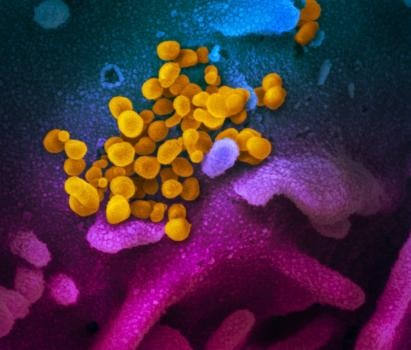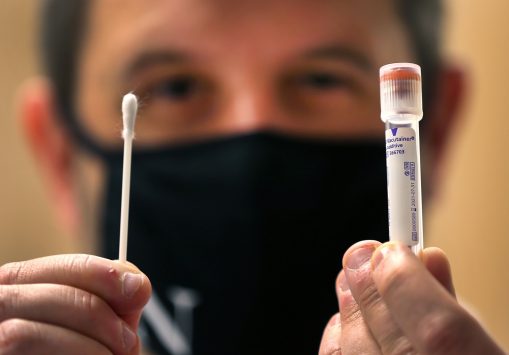SciCheck Digest
Polymerase chain reaction, or PCR, tests for COVID-19 are highly accurate. People on social media, however, are circulating lists of germs that they baselessly claim will cause such tests to be falsely positive. In reality, it’s the opposite. The lists include pathogens that have been tested by the manufacturers and did not react to the test.
Full Story
The Food and Drug Administration has authorized more than 200 different PCR tests since the COVID-19 pandemic began.
 Those tests have been among the most accurate for diagnosing the disease, although results can take longer to get than for rapid antigen tests since they are typically processed in a lab. Both the Cleveland Clinic and the then-director of the National Institutes of Health have called PCR tests the “gold standard” in detecting the virus that causes COVID-19.
Those tests have been among the most accurate for diagnosing the disease, although results can take longer to get than for rapid antigen tests since they are typically processed in a lab. Both the Cleveland Clinic and the then-director of the National Institutes of Health have called PCR tests the “gold standard” in detecting the virus that causes COVID-19.
The tests work by searching for stretches of genetic material in a person’s sample, typically a nasal swab or some saliva, that match those found in SARS-CoV-2, the virus that causes COVID-19. If the coronavirus is present, then a short snippet of genetic material is copied many times over, which can be read out on a machine. If the coronavirus isn’t there — or if there’s a different virus, such as influenza — then there’s no match, copies aren’t made, and there’s no signal to detect. Because those stretches are carefully selected to be sequences that are unique to the coronavirus, the tests are very specific — and almost never turn up positive because someone is infected with a different pathogen.
Despite the years of use and studies showing the effectiveness of PCR tests, online posts misleadingly claim to list more than 50 germs that could produce a false positive result on a PCR test.
The claim feeds into the longstanding partisan suggestion that the impact of COVID-19 — which has killed more than 870,000 people in the U.S. as of Jan. 27 — has been inflated.
The list appears to have originated on Telegram, a social media platform that has attracted a right-wing audience fleeing larger platforms that correct misinformation.
On Nov. 23, David Rodriguez, a former boxer who promotes far-right politics and embraced the QAnon conspiracy theory, posted the list on his Telegram channel with this message: “Did you know there are a total of 57 potential cross reactants that could give you a false positive when administering the PCR tests? It’s also note worthy, that Sars-Covi-2 has STILL not been isolated.” The list that follows catalogs a variety of pathogens — some misspelled — including common viruses, such as different types of influenza, along with various species of bacteria and fungi.
The next day, an Australian QAnon account posted the claim to Gab, another social media platform with a right-wing following. And other partisan accounts continued to share it.
Recently, the claim has bubbled up on Facebook, where it was posted by two chiropractors who have used their platforms to spread misinformation about the pandemic.
Anita Mihlon, a chiropractor in New Jersey who has posted anti-vaccination content for years, and Eric Nepute, a chiropractor in Missouri whom we’ve written about before, each posted the list with their own messages attached.

First, we’ll dispense with Rodriguez’s claim that SARS-CoV-2 hasn’t been isolated. Scientists in China first isolated the virus on Jan. 7, 2020. Scientists at the Centers for Disease Control and Prevention in the U.S. isolated the virus later that month, from a patient who was diagnosed with the disease in Washington state. Scientists in other countries have also isolated the virus. A picture of the isolated virus is at the right.
As for the rest of the claim — it’s not a list of germs that cause a PCR test to give false positives.
Rodriguez’s original post attributes the list to a package insert included with a COVID-19 PCR test from SDI Labs.
We asked SDI Labs for a copy of the materials included with the test, and the instructions they sent us for obtaining a patient sample did not include any such list. It’s worth noting that the sample would be sent to a lab, which would conduct the PCR test.
The summary of the test’s emergency use authorization from the Food and Drug Administration does, though, include many of the germs listed in the social media posts. However, they are included in a list of pathogens that the company tested and found did not react to the test. So it’s actually the opposite of what’s claimed in the posts.
“For EUA authorization, cross-reactivity studies are required (as noted in our template for test developers) to demonstrate that COVID-19 PCR diagnostic tests [do] not react with related pathogens, high prevalence disease agents, and normal or pathogenic flora that are reasonably likely to be encountered in a clinical sample,” Stephanie Caccomo, spokeswoman for the FDA, told us in an email.

Similarly, Matthew Binnicker, a professor of laboratory medicine and pathology at the Mayo Clinic, explained in an email that manufacturers typically go through several steps to ensure that their tests won’t return false-positive results.
“Oftentimes when a new PCR is developed, it is tested against a large panel of other organisms (we call this a cross-reactivity panel) to demonstrate that no cross-reactivity, or false-positives, occurs,” Binnicker said. “The long list of organisms that is shown in PCR instruction sheets summarizes the organisms that were analyzed/tested to ensure that false-positives were NOT observed.”
Basically, he said, “COVID-19 PCR tests are highly specific, and do not show cross-reactivity (false-positive results) with other viruses.”
In this case, germs that might interfere with SDI Lab’s test outcome were checked and found to be nonreactive.
It’s also telling that the list circulating on social media claiming to reveal germs that could obstruct COVID-19 test results includes “Pooled Human Nasal Wash.” That’s nasal fluid gathered from multiple human donors and sold for research. The FDA actually recommends that manufacturers use it in their testing “to represent diverse microbial flora in the human respiratory tract.” Its inclusion suggests that the list came from a misreading of regulatory documents.
We emailed Rodriguez to ask where he got his information and why he thought that the pathogens he listed would taint the test, but we didn’t hear back.
So, it looks like this is a situation in which someone with a background in boxing — not medicine — misconstrued how specific PCR tests are and how they’re evaluated for cross-reactivity. As is common for social media misinformation, his claim was repeated for weeks and advanced from conspiracy theory circles on niche sites to accounts that look authoritative on a major platform.
Editor’s note: SciCheck’s COVID-19/Vaccination Project is made possible by a grant from the Robert Wood Johnson Foundation. The foundation has no control over FactCheck.org’s editorial decisions, and the views expressed in our articles do not necessarily reflect the views of the foundation. The goal of the project is to increase exposure to accurate information about COVID-19 and vaccines, while decreasing the impact of misinformation.
Sources
Food and Drug Administration. Individual EUAs for Molecular Diagnostic Tests for SARS-CoV-2. Accessed 25 Jan 2022.
Cleveland Clinic. COVID-19 and PCR Testing. Updated 24 Aug 2021.
Collins, Francis. Former director, National Institutes of Health. “New Metric Identifies Coronavirus Hotspots in Real Time.” NIH Director’s Blog. 24 Jun 2021.
National Institutes of Health, National Human Genome Research Institute. Understanding COVID-19 PCR Testing. Updated 18 Jan 2022.
McDonald, Jessica. “The Facts on Coronavirus Testing.” FactCheck.org. 10 Mar 2020.
Centers for Disease Control and Prevention. COVID Data Tracker. Accessed 27 Jan 2022.
Feldstein, Steven and Sarah Gordon. “Are Telegram and Signal Havens for Right-Wing Extremists?” Foreign Policy. 13 Mar 2021.
World Health Organization. COVID-19 – China. 12 Jan 2020.
Harcourt, Jennifer, et al. Centers for Disease Control and Prevention. “Severe Acute Respiratory Syndrome Coronavirus 2 from Patient with Coronavirus Disease, United States.” Emerging Infectious Diseases. Jun 2020.
SDI Labs. Anterior Nasal Self-Collection Instructions. Accessed 26 Jan 2022.
Food and Drug Administration. Accelerated Emergency Use Authorization Summary. SDI SARS-CoV-2 Assay. Accessed 26 Jan 2022.
Caccomo, Stephanie. Spokeswoman, Food and Drug Administration. Email to FactCheck.org. 24 Jan 2022.
Binnicker, Matthew. Professor of laboratory medicine and pathology, Mayo Clinic. Email to FactCheck.org. 24 Jan 2022.
Food and Drug Administration. Template for Developers of Molecular Diagnostic Tests. 6 Oct 2021.